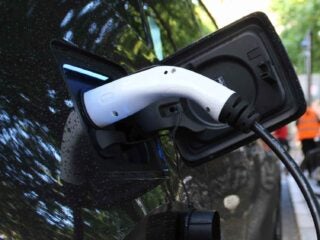- Resources
- Lyft commits to 100% electric vehicles by 2030. Here’s why it matters.
Resources
Lyft commits to 100% electric vehicles by 2030. Here’s why it matters.
Published: June 18, 2020 by Elizabeth Sturcken
Investor, employee and customer pressure on companies to help lead the way to a more sustainable, equitable and resilient future is at an all-time high. Their calls for leadership are only reinforced as the current administration continues to denigrate and divide, while the nation tries to recover from the devastation of COVID-19 and work for racial justice and equity.
Today, Lyft responded to stakeholder demands for rebuilding a better future — and in particular for climate action — through a bold commitment to reach 100% electric vehicles (EVs) on the Lyft platform by 2030.
This exciting move highlights the unprecedented opportunity for the private sector to fill the current leadership void on climate while also reducing air pollution, increasing consumer trust and solidifying brand reputation for the long-term.
Here are three reasons why Lyft’s new commitment — and its detailed plan to meet the 2030 target — could spark transformative change and inspire other business leaders to follow suit.
Transforming transportation is crucial
The Intergovernmental Panel on Climate Change report states that in order to avoid the worst economic and health impacts of a warming planet, we need to get to net zero emissions later this century. To achieve that, the U.S. and other advanced economies must meet the 100% clean target by 2050, at the latest.

Transportation — the biggest source of greenhouse gas (GHG) emissions in the U.S. and among the largest sources of local air pollution — must be transformed through zero-emissions solutions to meet this target. Passenger cars and trucks account for 60% of U.S. transportation emissions, and these vehicles are primed to lead the transition to a net zero future.
That’s why automotive manufacturers are investing billions to develop electric vehicles and have scores of models either already on the market or on track to be introduced in the next few years.
Today’s announcement from Lyft makes it clear that fleets, too, are ready to invest in the transition to a zero-emission future. To date, a few large fleets, including Biogen and New York City, have announced fleet-wide electrification goals.
Lyft’s efforts have the potential to have an outsized impact by helping accelerate electrification of passenger vehicles and by introducing more Americans to electric vehicles.
Reducing pollution from transportation can also improve public health, especially in some of our nation’s most vulnerable communities.
Supporting stakeholders and equitable access is just good business
Sustainable transportation solutions must work for people and for communities. For Lyft that starts with its riders, 40% of whose rides start or end in low-income areas, and its drivers, two-thirds of whom identify with a minority group.
Ensuring that the move to EVs delivers not just climate, but also health and economic benefits is critical, especially because doing what’s best for stakeholders can make or break a company’s reputation and market share.
Although turning Lyft’s plan into action won’t be easy, the company has made it clear that it’s committed to help “make driving an EV a profitable choice and …to helping drivers transition to [EVs] over time.” Further, the company noted that, “at the end of the day, meeting our commitment is on us, not on drivers.”
Lyft estimates that meeting its target will result in up to $10 billion in savings for drivers, from reduced vehicle operating expenses. Already, drivers in Lyft’s rental car program are saving $50-70 per week on fuel costs alone.
In addition to the EVs commitment, Lyft today also revealed its plan to help reduce disparities in transit. The company’s commitment to “expand access to multimodal technologies and trip planning to communities of color and low-income communities, particularly those disproportionately impacted by poor air quality,” is further evidence of putting people first.
Other commitments that could play a meaningful role in rebuilding a more equitable economy include: supporting policies aimed at directing at least 40% of green investment into disadvantaged communities; providing free bikeshare memberships for low-income teenagers; and, ensuring that bikes and scooters are placed in communities of color and low-income communities.
Knocking down policy barriers accelerates a clean economy
Having a plan to meet its commitment is essential, so it’s encouraging to see that Lyft has mapped out what needs to be done to transition the cars on its platform. However, as Lyft notes, reaching its target will require unprecedented leadership from policymakers and regulators to align market rules and incentives for businesses and consumers alike.
Long-term pollution standards are essential to drive zero-emission technology into U.S. fleets, protect human health, reduce climate pollution, and save people money in fuel costs. As we rebuild from the devastation caused by COVID-19, this is more important than ever.
The most powerful tool that a company has to fight climate change is its political influence. Fortunately, Lyft recognizes this and has already used its influence.
For example, Lyft supported maintaining the Clean Car Standards and has publicly committed to continue doing so as part of its EVs goal. Through this action, Lyft joined with other corporate voices — including Ford, Honda, BMW and VW — opposing the Trump Administration’s roll back of vehicle emission standards.
Just as importantly, Lyft is committed to continue using its political muscles to drive much needed policy changes, by “actively supporting” policies that can complement protective pollution standards.
We look forward to working with Lyft to secure transformation vehicle emission standards, accelerate the introduction of electric vehicles into the U.S. fleet, and develop a national charging infrastructure.
Of course, Lyft — or any one company alone — can’t by itself drive the change that is needed to build a cleaner future. It’s time for other companies to step up and meet this moment — and to secure that they’re on the right side of history.


